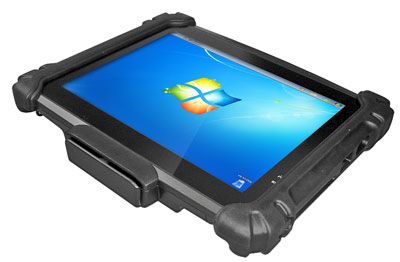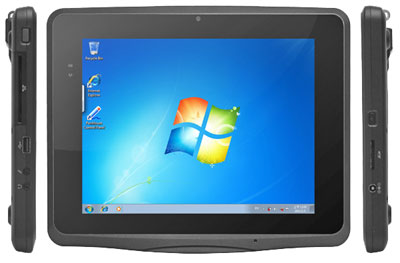|
DT Research DT315CT
Like a better protected iPad that runs Windows on a capactive touch screen and can be ordered with numerous data collection options
(by Conrad H. Blickenstorfer)
Covering yet more bases, on May 20, 2013, DT Research introduced the DT315CT Windows tablet, a slim, durable design that integrates a smart card reader for quick reading and verification of payments. The DT315CT has a 9.7-inch capacitive display, weighs about 2.7 pounds, offers various data capture and communications options, and provides good performance with a dual-core Intel Atom N2800 processor.

Available with or without protective rubber overlays, the DT315CT provides a good degree of ruggedness when needed, but can also be used without the bumpers. It then assumes the fashionable and popular consumer media tablet look.

As is, the DT315CT will undoubtedly appeal to those who love the iPad look, but need full Windows 7 (or its embedded version) for the job. That, and the various options and features that differentiate a media tablet from a true productivity tool for enterprise and business. The display offers the same 9.7-inch size in 4:3 aspect ratio as the iPad, and even the 1024 x 768 pixel resolution is the same as the first and second gen iPad. And there is friendly capacitive touch, and not the resistive digitizer or active pen (or both) usually available in Windows tablets.
Under the hood you find an Intel Atom N2800 processor. It's the faster of Intel's two mobile dual-core "Cedarview" processors, and by many seen as Intel's best overal Atom chip for mobile computers to-date. There's a generous 4GB of DDR3 RAM, from 8GB up to 256GB of Flash storage, plus an SD Card slot for even more.
Measuring 10.2 x 8.3 inches, the DT315CT has a footprint that's a bit larger than the iPad due to wider bezels. It's about twice as thick, too, and at 2.7 pounds considerably heavier than consumer tablets (but much lighter than traditional full-size vertical market Tablet PCs). The fashionably shaped ABS + PC body with its rubber bumpers is grippy and easy to hold and operate (and if you ever wondered what ABS + PC stands for, it's a tough resin blended from policarbonate and Acrylonitrile Butadiene Styrene polymer...).
Like most vertical market/industrial tablets, the DT315CT, which comes with a half-slot smart card reader, can be equipped with a variety of data capture options. Depending on application needs, the device may include a CMOS 2D area imager (which can also read 1D codes), a 3-track magnetic stripe reader that snaps onto the bottom, and a 5-megapixel camera with LED illuminator. On the wireless communications side, the DT315CT can be ordered with a PCIe-based Gobi 3G WWAN module that includes GPS for positioning and navigation as well. There's also an optional external battery pack that doubles the internal battery's relatively modest 28 watt hours to 56 watt hours.
On the ruggedness side, the ABS + PC enclosure combined with the rubber bumpers should make the tablet considerably hardier than your average media tablet. Keep in mind, though, that this is not really a rugged device. The specs state IP54 sealing (mostly protected agains dust and water spray from all directions), but that only goes for the front panel. The standard operating temperature range is a modest 41 to 95 degrees, suggesting that the DT315CT is meant to be used mostly indoors (though a special outdoor display option is available).
Overall, the DT315CT is an attractive choice for anyone who needs a nice Windows 7 tablet for apps where capacitive touch comes in handy, one that provides a nice balance between compact size and weight, battery life, and decent performance.
How do the tablets in DT Research's current tablet lineup differ? They mostly use the same or very similar electronics, but display sizes (7 to 10.4 inches), aspect ratios (standard 4:3 or wide), and resolutions (800 x 480 to 1024 x 768) vary. Most are in the 2-3 pound range, All offer good protection via large rubber bumpers, but ruggedness specs vary, as does the availability of options such as RFID, mobile broadband, cameras, etc. For good overview of the DT Research lineup, see the DT Research tablet summary, their very informative page on optional features and technologies, and their handy comparison feature..
|









